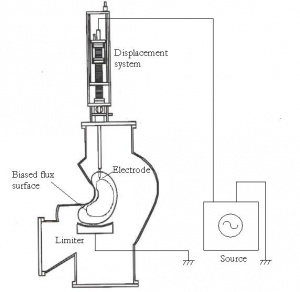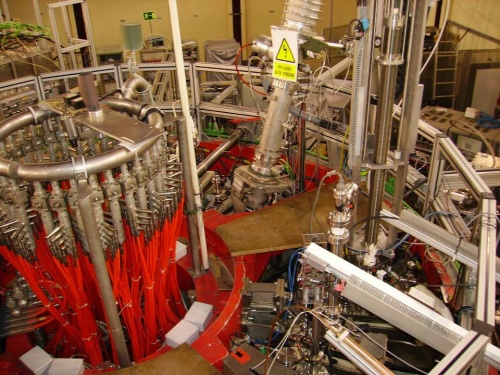TJ-II:Biasing probe: Difference between revisions
m Reverted edits by 211.46.97.1 (Talk) to last revision by Admin |
No edit summary |
||
| (7 intermediate revisions by 2 users not shown) | |||
| Line 1: | Line 1: | ||
[[File:TJ-II_Biasing_probe.jpg|300px|thumb|right| | [[File:TJ-II_Biasing_probe.jpg|300px|thumb|right|Conceptual diagram of the biasing probe, mounted on the [[TJ-II:Langmuir Probes|reciprocating probe]] drive]] | ||
At [[TJ-II]], a 2-D carbon composite mushroom shaped electrode (12 mm high with a diameter of 25 mm) has been developed and installed on a fast reciprocating probe drive. Typically, the electrode is inserted to a position 2 cm inside the last closed flux surface (LCFS) and biased positively (200-300 V) with respect to one of the two [[TJ-II:Limiter|TJ-II limiters]] located in the [[Scrape-Off Layer]] region (about 0.5 cm beyond the LCFS). Measured electrode currents are in the range of 30-50 A. | At [[TJ-II]], a 2-D carbon composite mushroom shaped electrode (12 mm high with a diameter of 25 mm) has been developed and installed on a fast reciprocating probe drive. Typically, the electrode is inserted to a position 2 cm inside the last closed flux surface (LCFS) and biased positively (200-300 V) with respect to one of the two [[TJ-II:Limiter|TJ-II limiters]] located in the [[Scrape-Off Layer]] region (about 0.5 cm beyond the LCFS). Measured electrode currents are in the range of 30-50 A. | ||
<ref> | |||
<ref>[http://www-pub.iaea.org/MTCD/Meetings/FEC2006/ex_p4-40.pdf | The impact of biasing on confinement properties has been studied to some depth. | ||
<ref>C. Silva et al, ''Transport and fluctuations during electrode biasing on TJ-II'', [[doi:10.1007/s10582-006-0044-3|Czech. J. Phys. '''55''' (2005) 1589]]</ref> | |||
<ref>M.A. Pedrosa et al, ''Transport and fluctuations during electrode biasing experiments on the TJ-II stellarator'', [http://www-pub.iaea.org/MTCD/Meetings/FEC2006/ex_p4-40.pdf Proc. 12<sup>st</sup> Fusion Energy Conf. (2006) EX-P4/40]</ref> | |||
<ref>Melnikov, A. V., Hidalgo, C., et al. (2004). ''Plasma Potential Measurements by the Heavy Ion Beam Probe Diagnostic in Fusion Plasmas: Biasing Experiments in the TJ-II Stellarator and T-10 Tokamak''. [[doi:10.13182/FST04-A568|Fusion Science and Technology, 46(2), 299–311]]</ref> | |||
<ref>B. van Milligen, T. Kalhoff, M. Pedrosa, and C. Hidalgo. ''Bicoherence during confinement transitions in the TJ-II stellarator''. [[doi:10.1088/0029-5515/48/11/115003|Nucl. Fusion, 48:115003, 2008]].</ref> | |||
<ref>B. van Milligen, M. Pedrosa, C. Hidalgo, B. Carreras, T. Estrada, J. Alonso, J. de Pablos, A. Melnikov, L. Krupnik, L. Eliseev, and S. Perfilov. ''The dynamics of the formation of the edge particle transport barrier at TJ-II''. [[doi:10.1088/0029-5515/51/11/113002|Nucl. Fusion, 51:113002, 2011]].</ref> | |||
<ref>B. van Milligen, J. Hernández Nicolau, B. Liu, G. Grenfell, U. Losada, B. Carreras, L. García, and C. Hidalgo. ''Filaments in the edge confinement region of TJ-II''. [[doi:10.1088/1741-4326/aa9db6|Nucl. Fusion, 58:026030, 2018]].</ref> | |||
In 2009, the power source (originally DC) has been upgraded to allow modulation with a frequency of up to a few kHz. | In 2009, the power source (originally DC) has been upgraded to allow modulation with a frequency of up to a few kHz. | ||
Location: [[TJ-II:Sectors|sector]] | Location: [[TJ-II:Sectors|sector]] A8 (φ = 174.4 °). | ||
Signal names in the [[TJ-II:Shot_database|TJ-II database]]: | Signal names in the [[TJ-II:Shot_database|TJ-II database]]: | ||
'PolI', 'PolV'. | 'PolI', 'PolV'. | ||
Latest revision as of 08:14, 1 May 2024

At TJ-II, a 2-D carbon composite mushroom shaped electrode (12 mm high with a diameter of 25 mm) has been developed and installed on a fast reciprocating probe drive. Typically, the electrode is inserted to a position 2 cm inside the last closed flux surface (LCFS) and biased positively (200-300 V) with respect to one of the two TJ-II limiters located in the Scrape-Off Layer region (about 0.5 cm beyond the LCFS). Measured electrode currents are in the range of 30-50 A.
The impact of biasing on confinement properties has been studied to some depth. [1] [2] [3] [4] [5] [6]
In 2009, the power source (originally DC) has been upgraded to allow modulation with a frequency of up to a few kHz.
Location: sector A8 (φ = 174.4 °). Signal names in the TJ-II database: 'PolI', 'PolV'.

References
- ↑ C. Silva et al, Transport and fluctuations during electrode biasing on TJ-II, Czech. J. Phys. 55 (2005) 1589
- ↑ M.A. Pedrosa et al, Transport and fluctuations during electrode biasing experiments on the TJ-II stellarator, Proc. 12st Fusion Energy Conf. (2006) EX-P4/40
- ↑ Melnikov, A. V., Hidalgo, C., et al. (2004). Plasma Potential Measurements by the Heavy Ion Beam Probe Diagnostic in Fusion Plasmas: Biasing Experiments in the TJ-II Stellarator and T-10 Tokamak. Fusion Science and Technology, 46(2), 299–311
- ↑ B. van Milligen, T. Kalhoff, M. Pedrosa, and C. Hidalgo. Bicoherence during confinement transitions in the TJ-II stellarator. Nucl. Fusion, 48:115003, 2008.
- ↑ B. van Milligen, M. Pedrosa, C. Hidalgo, B. Carreras, T. Estrada, J. Alonso, J. de Pablos, A. Melnikov, L. Krupnik, L. Eliseev, and S. Perfilov. The dynamics of the formation of the edge particle transport barrier at TJ-II. Nucl. Fusion, 51:113002, 2011.
- ↑ B. van Milligen, J. Hernández Nicolau, B. Liu, G. Grenfell, U. Losada, B. Carreras, L. García, and C. Hidalgo. Filaments in the edge confinement region of TJ-II. Nucl. Fusion, 58:026030, 2018.